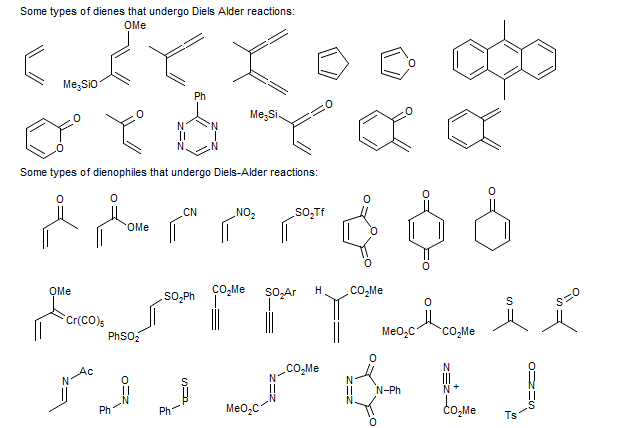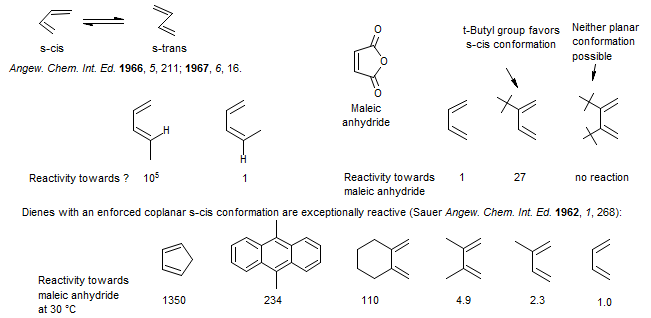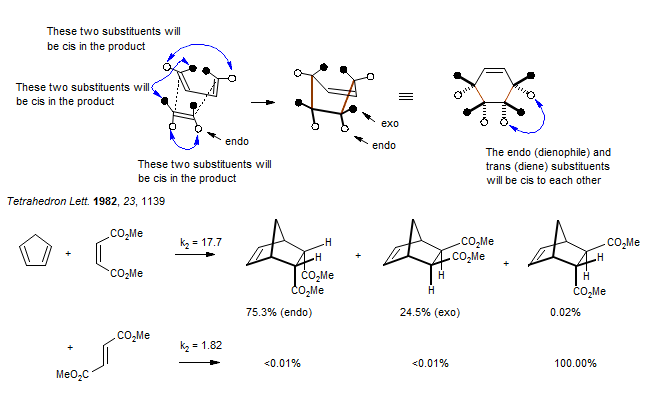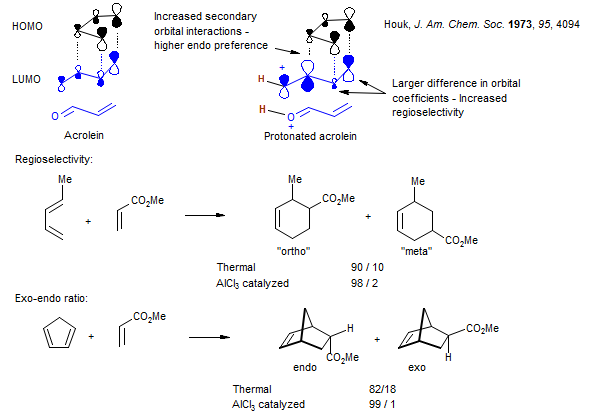The Diels-Alder Reaction
The Diels-Alder Reaction in Total Synthesis,
Nicolaou, K. C.; Snyder, S. A.; Montagnon, T.; Vassilikogiannakis, G. Angew. Chem. Int. Ed. 2002 , 41, 1668 -1698.
Diels Alder Kinetics
Sauer, J. Angew. Chem. Int. Ed. 1967 , 6, 16; Sauer, J.; Sustman, R. Angew. Chem. Int. Ed. 1980 , 19, 779.
Cycloaddition Reactions of Heteroaromatic Six-membered Rings,
Katritzky, A. R. Dennis, N. Chem. Rev. 1989, 89, 827.
Diels-Alder Reactions of Cycloalkenones in Organic Synthesis. A Review,
Finguelli, F.; Taticchi, A.; Wenkert, E. Org. Prep. Proc. Int. 1990, 22, 131.
Reactivity and Selectivity in Lewis Acid-Catalyzed Diels-Alder Reactions of 2-Cyclohexenones,
Fringuelli, F.; Minuti, L.; Pizzo, F.; Taticchi, A. Act. Chem. Scand. 1993, 47, 255.
Dienes in the Diels-Alder Reaction,
Fringuelli, F.; Taticchi, A., Wiley: New York, 1990.
Silyloxydienes in Organic Synthesis,
Danishefsky, S. Acct. Chem. Res., 1981, 14, 400-406.
Acceleration and Selectivity Enhancement of Diels-Alder Reactions by Special and Catalytic Methods,
Pindur, U.; Lutz, G.; Otto, C. Chem. Rev. 1993, 93, 741.
Diels-Alder Cycloadditions of 2-Pyrones and 2-Pyridones,
Afarinkia, K.; Vinader, V.; Nelson, T. D.; Posner, G. H. Tetrahedron 1992, 48, 9111.
Tandem Diels-Alder Cycloadditions in Organic Synthesis,
Winkler, J. D. Chem. Rev. 1996, 96, 167-76.
Tandem Reactions Combining Diels-Alder Reactions with Sigmatropic Rearrangement Processes and Their Use in Synthesis,
Neuschutz, K.; Velker, J.; Neier, R. Synthesis 1998, 227-55.
Synthetic Equivalents of Cyclohexatriene in [4 + 2] Cycloaddition Reactions. Methods for Preparing Cycloadducts to Benzene,
Cossu, S.; Fabris, F.; De Lucchi, O. Synlett 1997, 1327-34.
Synthetic Applications of Furan Diels-Alder Chemistry,
Kappe, C. O.; Murphree, S. S.; Padwa, A. Tetrahedron 1997, 53, 14179-231.
Salt Effects on Diels-Alder Reaction Kinetics,
Kumar, A. Chem. Rev. 2001, 101, 1-19.
Recent Advances in Lewis Acid-Catalyzed Diels-Alder Reactions in Aqueous Media,
Fringuelli, F.; Piermatti, O.; Pizzo, F.; Vaccaro, L. Europ. J. Org. Chem. 2001, 3, 439-55.
Diels-Alder Reactions in Water,
Otto, S.; Engberts, J. B. F. N. Pure. Appl. Chem. 2000, 72, 1365-72.
Diels-Alder Reactions on Solid Supports
Yli-Kauhaluoma, J. Tetrahedron 2001, 57, 7053-71.
Diels-Alder Reactions of Anthracene, 9-Substituted Anthracenes and 9,10-Disubstituted Anthracenes
Atherton, J. C. C.; Jones, S. Tetrahedron 2003, 59, 9039-57
Recent Advances in Natural Product Synthesis by Using Intramolecular Diels-Alder Reactions
Takao, K.; Munakata, R.; Tadano, K. Chem. Rev. 2005, 105, 4779-807.
The Diels-Alder reaction (also known as the Diene Synthesis) is the reaction of a 1,3-butadiene with an alkene to form a cyclohexene. One of the first cycloadditions performed by Diels and Alder (Nobel Prize 1950) was the reaction of cyclopentadiene with p-benzoquinone (Diels, O.; Alder, K. Liebigs Ann. Chem. 1928, 460, 98). Quinone cycloadditions have been frequently used in natural product syntheses, including the cyclopentadiene-benzoquinone adduct iteself in the synthesis of epi-Epoxydon.
Nobel-Prize-winning chemistry
O. Diels, K. Alder, 1950

Dendrobine: Kende, A. S.; Bentley, T. J.; Mader, R. A.; Ridge, D. J. Am. Chem. Soc. 1974, 96, 4332-4334. DOI

Miltirone: Lee, J.; Mei, H. S.; Snyder, J. K J. Org. Chem. 1990, 55, 5013 (see also J. Org. Chem. 1985, 50, 4996) DOI

Scope
The scope of the Diels-Alder reaction is very broad, including not only many substituted dienes and alkenes, but numerous heteroanalogs of both the diene and the dienophile.

Diels-Alder topics to be covered:
1. Reactivity: s-cis conformation, electronic effects
2. Regioselectivity (ortho/meta, para/meta)
3. Stereospecificity: cis-dienophilies go to cis cyclohexenes, trans-trans dienes go to cis-1,4-cyclohexenes
4. Stereoselectivity: Alder endo rule
5. Facial selectivity in diene and dienophile
6. Enantioselectivity - chiral auxiliaries and chiral catalysts
7. Inverse electron demand Diels-Alder reactions
8. Retro-Diels-Alder reactions
Reactivity
Conformation of Diene: Only dienes which can adopt the s-cis conformation undergo facile Diels-Alder reactions. Any substitution pattern which favors the s-trans isomer slows down the cycloaddition. Especially unfavorable are cis-substituents on the diene, which usually prevent successful cycloadditions from being performed..

Electronic Effects: Most successful Diels-Alder reactions involve an electronic imbalance between diene and dienophile - usually the diene is electron rich (the donor) and the dienophile is electron poor (the acceptor). Thus dienes with π-electron donating substituents like alkyl, methoxy, and dialkylamino show increased reactivity, as do dienophiles with substituents like C(=O)R, C≡N, NO2 and SO2Ph. Generally, 1-substituents have a larger reactivity effect than 2-substituents

It is also possible to have Diels-Alder reactions with inverse electron demand, where the diene is electron deficient.
Steric Effects: Because of the compact cyclic nature of the Diels-Alder transition state, the reaction is very sensitive to steric effects at all positions except the two central positions on the diene. Alkyl groups on the dienophile are especially problematic because the electronic and steric effects are in the same direction.

Stereospecificity
The Diels-Alder reaction involves a stereospecific cis addition (suprafacial) to both the diene and dienophile. Existing stereochemical relationships in the dienophile (cis or trans) and the diene (trans-trans or cis-trans) are translated into stereochemical relationships in the product.

Stereoselectivity
The Alder Endo Rule: the unsaturated substituent on the dienophile generally prefers the endo position in the transition state. Since this is usually the more sterically crowded isomer, Diels-Alder reactions can show different endo/exo ratios under conditions of kinetic and thermodynamic control. The endo-selectivity is not usually very large, with values between 4:1 and 10:1 being common.

Facial Selectivity: If the diene or dienophile does not have planar symmetry, then there may be substantial face-selectivity in Diels-Alder reactions resulting from combinations of steric and electronic effects.
Intermediate in prostaglandin synthesis: Corey, E. J. J. Am. Chem. Soc. 1969, 91, 5675.

Regioselectivity
The regioselectivity of the Diels-Alder reaction of unsymmetrical dienes with unsymmetrical dienophiles can be predicted by the ortho-para rule. As with diene reactivity, 1-substituents generally have a larger directing effect than 2-substituents.

The directive effect of 1-substituents on the diene is generally higher than that of 2-substituents, so the 1-substituent will tend to dominate if the two substituents conflict:

The ortho-para directive effects can be rationalized at several levels. A simple device that works well is to examine the diradicals formed if we assume the cycloaddition was stepwise (the cycloaddition is usually concerted, but the transition state can be thought of as having diradical character). In the example below, the boxed diradical has both radical centers stabilized by the substituents R and CO2Me, and thus this will lead to the major product.

A more sophisticated model is provided by the FMO approximation outlined earlier.
Lewis Acid Catalysis
Complexation of the dienophile with a protic or Lewis acid has dramatic effects on many Diels-Alder cycloadditions. Rates of reaction are increased by factors as large as 106, the preference for endo stereoselectivity is increased, and the ortho-para selectivity may also be higher. This is a consequence of the lowering of the LUMO of the dienophile by the increased electron deficiency caused by the Lewis acid, and changes in the orbital coefficients which cause stronger secondary orbital interactions and larger regiochemical preference. There are also downsides to adding Lewis or protic acids - poluymerization or other decomposition reactions may be accelerated also.

Steroid synthesis: Stork, G.; Clark, G.; Shiner, C. S. J. Am. Chem. Soc. 1881, 103, 4948.

Changes in regioselectivity: "Lewis Acid-Catalyzed Diels-Alder Reactions of peri-Hydroxylated Naphthoquinones: A Regiochemical Divergence" Kelly, T. R.; Montury, M. Tetrahedron Lett. 1978, 19, 4311. DOI
